电源内阻:扼杀DC-DC转换效率的元凶(Source Res
电源内阻:扼杀DC-DC转换效率的元凶
Abstract: DC-DC converters, common in battery-driven, portable, and other high-efficiency systems, can deliver efficiencies greater than 95% while boosting, reducing, or inverting supply voltages. Resistance in the power source is one of the most important factors that can limit efficiency. This application note describes the effects of source resistance, how to calculate efficiency, real-world considerations, design considerations, and shows a real-world example. DC-DC converters are commonly used in battery-operated equipment and other power-conserving applications. Like a linear regulator, the DC-DC converter can regulate to a lower voltage. Unlike linear regulators, however, the DC-DC converter can boost an input voltage or invert it to create a negative voltage. As an added bonus, the DC-DC converter boasts efficiencies greater than 95% under optimum conditions. However, this efficiency is limited by dissipative components. The main cause is resistance in the power source. Losses due to source resistance can lower the efficiency by 10% or more, exclusive of loss in the DC-DC converter! If the converter has adequate input voltage, its output will be normal and there may be no obvious indication that power is being wasted. Fortunately, testing the input efficiency is a simple matter (see the Source section).A large source resistance can cause other, less obvious effects. In extreme cases, the converter's input can become bistable, or its output can decrease under maximum load conditions. Bistability means that the converter exhibits two stable input conditions, each with its own efficiency. The converter output is normal, but system efficiency may be drastically affected (see How to Avoid Bistability).Should this problem be solved simply by minimizing the source resistance? No, because the practical limits and cost/benefit trade-offs posed by the system may suggest other solutions. A prudent selection of power-supply input voltage, for example, can considerably minimize the need for low source resistance. Higher input voltage for a DC-DC converter limits the input current requirement, which in turn lessens the need for a low source resistance. From a systems standpoint, the conversion of 5V to 2.5V may be far more efficient than the conversion of 3.3V to 2.5V. Each option must be evaluated. The goal of this article is to provide analytic and intuitive tools for simplifying the evaluation task.
A Systems View
As shown in Figure 1, any regulated power-distribution system can be divided into three basic sections: source, regulator(s) (a DC-DC converter in this case), and load(s). The source can be a battery or a DC power supply that is either regulated or unregulated. Unfortunately, the source also includes all the dissipative elements between the DC voltage and load: voltage-source output impedance; wiring resistance; and the resistance of contacts, PC-board lands, series filters, series switches, hot-swap circuits, etc. These elements can seriously degrade system efficiency.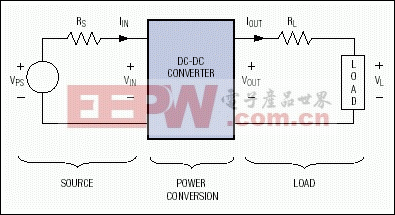
 Assuming that the regulator draws a negligible amount of current when unloaded, you can measure source efficiency as the ratio of VIN with the regulator at full load to VIN with the regulator unloaded.The regulator (DC-DC converter) consists of a controller IC and associated discrete components. Its characterization is described in the manufacturer's data sheet. Efficiency for the DC-DC converter (EFFDCDC) equals (power delivered by the converter)/(power delivered to the converter) multiplied by 100%:
Assuming that the regulator draws a negligible amount of current when unloaded, you can measure source efficiency as the ratio of VIN with the regulator at full load to VIN with the regulator unloaded.The regulator (DC-DC converter) consists of a controller IC and associated discrete components. Its characterization is described in the manufacturer's data sheet. Efficiency for the DC-DC converter (EFFDCDC) equals (power delivered by the converter)/(power delivered to the converter) multiplied by 100%: As specified by the manufacturer, this efficiency is a function of input voltage, output voltage, and output load current. It's not unusual for the efficiency to vary no more than a few percent over a load current range exceeding two orders of magnitude. Because the output voltage is fixed, we can say the efficiency varies only a few percent over an "output-power range" exceeding two orders of magnitude.DC-DC converters are most efficient when the input voltage is closest to the output voltage. If the input variation is not extreme with respect to the data sheet specifications, however, the converter's efficiency can usually be approximated as a constant between 75% and 95%:
As specified by the manufacturer, this efficiency is a function of input voltage, output voltage, and output load current. It's not unusual for the efficiency to vary no more than a few percent over a load current range exceeding two orders of magnitude. Because the output voltage is fixed, we can say the efficiency varies only a few percent over an "output-power range" exceeding two orders of magnitude.DC-DC converters are most efficient when the input voltage is closest to the output voltage. If the input variation is not extreme with respect to the data sheet specifications, however, the converter's efficiency can usually be approximated as a constant between 75% and 95%: This discussion treats the DC-DC converter as a twoport black box. For those interested in the nuances of DC-DC converter design, see References 1-3. The load includes the device to be driven and all dissipative elements in series with it, such as PC-trace resistance, contact resistance, cable resistance, etc. Because the DC-DC converter's output resistance is included in the manufacturer's data sheet, that quantity is specifically excluded. Load efficiency (EFFLOAD) equals (power delivered to the load)/(power delivered by the DC-DC converter) multiplied by 100%:
This discussion treats the DC-DC converter as a twoport black box. For those interested in the nuances of DC-DC converter design, see References 1-3. The load includes the device to be driven and all dissipative elements in series with it, such as PC-trace resistance, contact resistance, cable resistance, etc. Because the DC-DC converter's output resistance is included in the manufacturer's data sheet, that quantity is specifically excluded. Load efficiency (EFFLOAD) equals (power delivered to the load)/(power delivered by the DC-DC converter) multiplied by 100%: The key to optimum system designs is in analyzing and understanding the interaction between the DC-DC converter and its source. To do this we first define an ideal converter, then calculate the source efficiency, then test our assumptions against measured data from a representative DC-DC converterµin this case, the MAX1626 buck regulator.
The key to optimum system designs is in analyzing and understanding the interaction between the DC-DC converter and its source. To do this we first define an ideal converter, then calculate the source efficiency, then test our assumptions against measured data from a representative DC-DC converterµin this case, the MAX1626 buck regulator.
The Ideal DC-DC Converter
An ideal DC-DC converter would have 100% efficiency, operate over arbitrary input- and output-voltage ranges, and supply arbitrary currents to the load. It would also be arbitrarily small and available for free! For this analysis, however, we assume only that the converter's efficiency is constant, such that input power is proportional to output power: For a given load, this condition implies that the input current-voltage (I-V) curve is hyperbolic and exhibits a negative differential-resistance characteristic over its full range (Figure 2). This plot presents I-V curves for the DC-DC converter as a function of increasing input power. For real systems with dynamic loads, these curves are also dynamic. That is, the power curve moves farther from the origin as the load demands more current. Considering a regulator from the input port instead of the output port is an unusual point of view. After all, regulators are designed to provide a constant-voltage (sometimes constant-current) output. Their specifications predominantly describe the output characteristics (output-voltage range, output-current range, output ripple, transient response, etc.). The input, however, displays a curious property: within its operating range it acts as a constantpower load (Reference 4). Constant-power loads are useful in the design of battery testers, among other tasks.
For a given load, this condition implies that the input current-voltage (I-V) curve is hyperbolic and exhibits a negative differential-resistance characteristic over its full range (Figure 2). This plot presents I-V curves for the DC-DC converter as a function of increasing input power. For real systems with dynamic loads, these curves are also dynamic. That is, the power curve moves farther from the origin as the load demands more current. Considering a regulator from the input port instead of the output port is an unusual point of view. After all, regulators are designed to provide a constant-voltage (sometimes constant-current) output. Their specifications predominantly describe the output characteristics (output-voltage range, output-current range, output ripple, transient response, etc.). The input, however, displays a curious property: within its operating range it acts as a constantpower load (Reference 4). Constant-power loads are useful in the design of battery testers, among other tasks.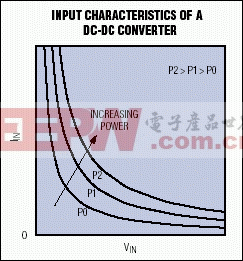
 IIN can also be solved in terms of VPS, VIN, and RS:
IIN can also be solved in terms of VPS, VIN, and RS: Equate the expressions from equations [6] and [7] and solve for VIN:
Equate the expressions from equations [6] and [7] and solve for VIN: To understand their implications, it is very instructive to visualize equations [6] and [7] graphically (Figure 3). The resistor load line is a plot of all possible solutions of equation [7], and the DC-DC I-V curve is a plot of all possible solutions of equation [6]. The intersections of these curves, representing solutions to the pair of simultaneous equations, define stable voltages and currents at the DC-DC converter's input. Because the DC-DC curve represents constant input power, (VIN+)(IIN+) = (VIN-) (IIN-). (The + and - suffixes refer to the two solutions predicted by equation [8], and correspond to the ± signs in the numerator.)
To understand their implications, it is very instructive to visualize equations [6] and [7] graphically (Figure 3). The resistor load line is a plot of all possible solutions of equation [7], and the DC-DC I-V curve is a plot of all possible solutions of equation [6]. The intersections of these curves, representing solutions to the pair of simultaneous equations, define stable voltages and currents at the DC-DC converter's input. Because the DC-DC curve represents constant input power, (VIN+)(IIN+) = (VIN-) (IIN-). (The + and - suffixes refer to the two solutions predicted by equation [8], and correspond to the ± signs in the numerator.)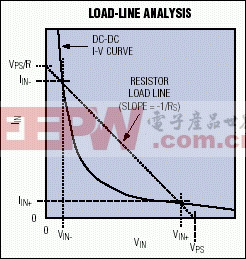
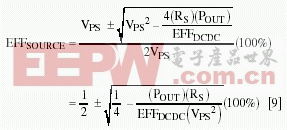 It's easy to get lost in the equations, and therein lies the value of the load-line analysis plot of Figure 3. Note, for example, that if the series resistance (RS) equals zero, the resistor load-line slope becomes infinite. The load line would then be a vertical line passing through VPS. At this point VIN+ = VPS and the efficiency would be 100%. As RS increases from 0Ω, the load line continues to pass through VPS but leans more and more to the left. Concurrently, VIN+ and VIN- converge on VPS/2, which is also the 50% efficiency point. When the load line is tangent to the I-V curve, equation [8] has only one solution. For larger RS, the equation has no real solution and the DC-DC converter no longer functions properly.
It's easy to get lost in the equations, and therein lies the value of the load-line analysis plot of Figure 3. Note, for example, that if the series resistance (RS) equals zero, the resistor load-line slope becomes infinite. The load line would then be a vertical line passing through VPS. At this point VIN+ = VPS and the efficiency would be 100%. As RS increases from 0Ω, the load line continues to pass through VPS but leans more and more to the left. Concurrently, VIN+ and VIN- converge on VPS/2, which is also the 50% efficiency point. When the load line is tangent to the I-V curve, equation [8] has only one solution. For larger RS, the equation has no real solution and the DC-DC converter no longer functions properly.
DC-DC Converters-Theory vs. Practice
How do these ideal-input curves compare with those of an actual DC-DC converter? To examine this question, a standard MAX1626 evaluation kit (Figure 4) was configured for an output voltage of 3.3V and a load resistor of 6.6Ω. We then measured the input's I-V curve (Figure 5). Several nonideal characteristics were evident immediately. Note, for example, that for very low input voltages the input current is zero. A built-in undervoltage lockout (denoted as VL) ensures that the DC-DC converter is off for all input voltages below VL. Otherwise, large input currents could be drawn from the power supply during start-up.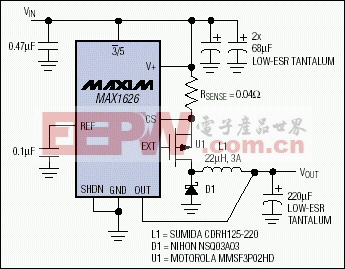 Figure 5. Above VMIN, the MAX1626 input I-V characteristic closely matches that of a 90%-efficient ideal device.When VIN exceeds VL, the input current climbs toward a maximum that occurs when VOUT first reaches the preset output voltage (3.3V). The corresponding input voltage (VMIN) is the minimum required by the DC-DC converter to produce the preset output voltage. For VIN VMIN, the constant-power curve for 90% efficiency closely matches the MAX1626 input curve. Variations from the ideal are caused primarily by small variations in DC-DC converter efficiency as a function of its input voltage.
Figure 5. Above VMIN, the MAX1626 input I-V characteristic closely matches that of a 90%-efficient ideal device.When VIN exceeds VL, the input current climbs toward a maximum that occurs when VOUT first reaches the preset output voltage (3.3V). The corresponding input voltage (VMIN) is the minimum required by the DC-DC converter to produce the preset output voltage. For VIN VMIN, the constant-power curve for 90% efficiency closely matches the MAX1626 input curve. Variations from the ideal are caused primarily by small variations in DC-DC converter efficiency as a function of its input voltage.
How to Avoid Bistability
The power-supply designer must also guarantee that the DC-DC converter never becomes bistable. Bistability is possible in systems for which the load line intersects the DC-DC converter curve at or below VMIN/IMAX (Figure 6).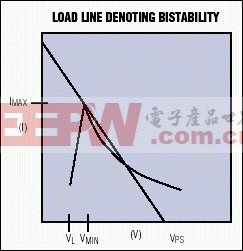 In Figure 6, the load-line resistance (RS, which has a value of -1/slope) has an upper limit called RBISTABLE:
In Figure 6, the load-line resistance (RS, which has a value of -1/slope) has an upper limit called RBISTABLE: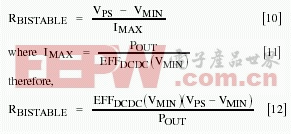 The source resistance (RS) should always be smaller than RBISTABLE. If this rule is broken, you risk highly inefficient operation or a complete shutdown of the DC-DC converter.
The source resistance (RS) should always be smaller than RBISTABLE. If this rule is broken, you risk highly inefficient operation or a complete shutdown of the DC-DC converter.
An Actual Case
It might be helpful to plot, for an actual system, the relationship shown in equation [9] between source efficiency and source resistance (Figure 7). Assume the following conditions: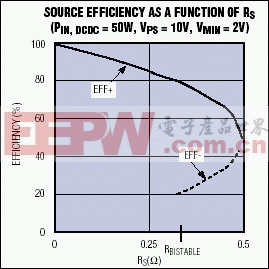 Using equation [12], RBISTABLE can be calculated as 0.320Ω. Subsequently, a plot of equation [9] shows that source efficiency drops as RS increases, losing 20% at RS = RBISTABLE. Note: this result cannot be generalized. You must perform the calculations for each application. One component of RS is the finite output resistance found in all power supplies, determined by the load regulation and usually defined as:Load Regulation =
Using equation [12], RBISTABLE can be calculated as 0.320Ω. Subsequently, a plot of equation [9] shows that source efficiency drops as RS increases, losing 20% at RS = RBISTABLE. Note: this result cannot be generalized. You must perform the calculations for each application. One component of RS is the finite output resistance found in all power supplies, determined by the load regulation and usually defined as:Load Regulation = A 5V/10A power supply with 1% load regulation, for example, would have only 5.0mΩ of output resistance- not much for a 10A load.
A 5V/10A power supply with 1% load regulation, for example, would have only 5.0mΩ of output resistance- not much for a 10A load.
Source Efficiency for Common Applications
It's useful to know how much source resistance (RS) can be tolerated and how this parameter affects system efficiency. RS must be less than RBISTABLE, as stated earlier, but how much lower should it be? To answer this question, solve equation [9] for RS in terms of EFFSOURCE, for EFFSOURCE values of 95%, 90%, and 85%. RS95 is the RS value that yields a 95% source efficiency for the given input and output conditions. Consider the following four example applications using common DC-DC converter systems.Example 1 derives 3.3V from 5V with a load current of 2A. For 95% source efficiency, be careful to keep the resistance between the 5V source and the DC-DC converter's input well under 162m½. Notice that RS90 = RBISTABLE, by coincidence. This value of RS90 also implies that the efficiency could as easily be 10% as 90%! Note that system efficiency (as opposed to source efficiency) is the product of source efficiency, DC-DC converter efficiency, and load efficiency.Example 1. Application Using a MAX797 or MAX1653 DC-DC Converter (IOUT = 2A)
| VPS | VOUT | IOUT | VMIN | EFFDCDC | POUT | RBISTABLE | RS95 | RS90 | RS85 |
| 5V | 3.3V | 2A | 4.5V | 90% | 6.6W | 0.307Ω | 0.162Ω | 0.307Ω | 0.435Ω |
| VPS | VOUT | IOUT | VMIN | EFFDCDC | POUT | RBISTABLE | RS95 | RS90 | RS85 |
| 5V | 3.3V | 20A | 4.5V | 90% | 66W | 0.031Ω | 0.016Ω | 0.031Ω | 0.043Ω |
| VPS | VOUT | IOUT | VMIN | EFFDCDC | POUT | RBISTABLE | RS95 | RS90 | RS85 |
| 4.5V | 1.6V | 5A | 2.5V | 92% | 8W | 0.575Ω | 0.111Ω | 0.210Ω | 0.297Ω |
| VPS | VOUT | IOUT | VMIN | EFFDCDC | POUT | RBISTABLE | RS95 | RS90 | RS85 |
| 15V | 1.6V | 5A | 2.5V | 86% | 8W | 3.359Ω | 1.149Ω | 2.177Ω | 3.084Ω |
Conclusion
When looking at DC-DC converter specifications, it is tempting to maximize efficiency by setting the supply voltage as close to the output voltage as possible. This strategy, however, can increase costs by placing unnecessary limitations on elements such as the wiring, connectors, and trace layout. System efficiency may even suffer. The analytic tools presented in this article should make such power-system trade-offs more intuitive and obvious.
References
- Erickson, Robert W. Fundamentals of Power Electronics. Chapman and Hall, 1997.
- Lenk, Ron. Practical Design of Power Supplies. IEEE Press McGraw Hill, 1998.
- Gottlieb, Irving M. Power Supplies, Switching Regulators, Inverters and Converters. Second Edition, TAB Books, 1994.
- Wettroth, John. "Controller Provides Constant Power Load." EDN, March 14, 1997.



评论